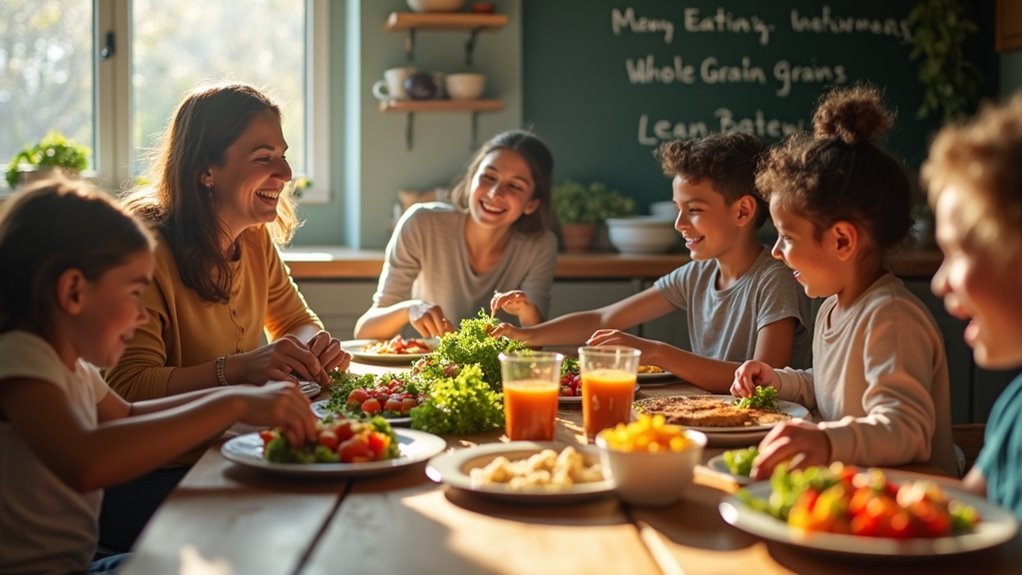Family meals are more than just a time to eat; they're a great chance to teach kids about nutrition! When you sit down together, it sparks conversations about healthy choices and the fun of trying new foods. Kids learn to appreciate colorful fruits and veggies while you share kitchen stories and laughter. Involving them in meal planning or cooking helps them feel proud of their choices, too. Plus, you can reinforce the message that eating together is just as important as what's on the plate. Stick around, and you'll discover even more ways to make mealtime fun and educational!
Importance of Family Meals
Family meals often play an essential role in fostering connections and improving nutrition. When you gather around the table, it's not just about the food. It's about sharing stories, laughter, and creating memories. You might find that those moments help strengthen your family's bond. After all, who doesn't love a good laugh over a plate of spaghetti?
Eating together also encourages healthier choices. When you cook as a family, you're more likely to whip up nutritious meals instead of grabbing fast food on the go. Plus, kids often try new foods when they see their parents enjoying them. You know what they say: "Monkey see, monkey do!"
So, the next time you're making a colorful salad, invite your little ones to help. They might even become your sous-chefs!
And let's not forget the simple act of sitting down together. It slows things down, allowing you to appreciate the food and each other's company.
Nutrition Education Defined
Nutrition education focuses on teaching individuals and families about the principles of healthy eating and the importance of nutrition in daily life.
It's like having a personal coach for your food choices! You learn what foods help your body grow, keep your energy up, and even make your mood brighter.
You might hear about things like fruits, veggies, whole grains, and proteins—basically, the superheroes of the food world. They can fight off hunger and keep you feeling good.
It's not just about eating salad and saying no to pizza, though. Nutrition education helps you understand balance. You can still enjoy your favorite treats, just in moderation!
Involving the whole family makes it even better. When you all learn together, it turns into a fun adventure.
You can try new recipes, explore local markets, or even pack healthy lunches together. Plus, sharing these experiences can help everyone remember the lessons more easily.
Benefits of Shared Meals
Sharing meals together creates a unique bonding experience that goes beyond just eating. When you sit down with family or friends, you're not just filling your stomach; you're also filling your heart. These shared moments help strengthen relationships and create lasting memories. Imagine the laughter, the stories, and maybe even a little friendly food competition!
During meals, you get the chance to connect and communicate. It's a perfect time to catch up on each other's lives, share funny moments, or even talk about your day's adventures. Plus, sitting together at a table encourages everyone to slow down and appreciate the food.
You might discover new favorite dishes or even start a fun family tradition, like taco night or pizza-making parties. These shared meals can also spark creativity in the kitchen. Who knows? You could end up inventing a recipe that becomes a family favorite!
In short, shared meals offer more than just good food. They bring you closer, create fun experiences, and help you appreciate the simple joys of life. So, gather your loved ones and enjoy those delicious moments together!
Teaching Healthy Choices
Gathering around the table offers a perfect opportunity to introduce and discuss healthy eating habits. This is your chance to turn meal times into fun learning moments! You can start by chatting about the colorful fruits and veggies on your plates. Ask your family what their favorites are, and why they're good for you. Did you know that carrots can help you see better in the dark? It's true!
When you talk about healthy choices, you're not just sharing facts; you're creating memories. You might say, "Hey, how about we try a new recipe with spinach?" This keeps everyone excited and enthusiastic to learn.
Plus, you can bring in fun challenges, like seeing who can come up with the wackiest fruit names or the best smoothie combination.
Don't forget to highlight the importance of balance. Talk about how cookies are tasty but should be enjoyed in moderation. It's all about making smart choices together.
Encouraging Cooking Together
Cooking together is a fantastic way to bond as a family while teaching valuable skills. When you gather in the kitchen, everyone can pitch in, making it a fun and exciting learning experience. You might chop veggies, stir sauces, or even measure flour. Each task helps you learn something new, like how to use a knife safely or the importance of following a recipe.
Plus, cooking together opens the door for creativity. You can experiment with flavors, swap ingredients, or come up with your own dishes. Who knows? You might even invent a family favorite!
And let's not forget about the laughter; cooking can get messy, and that's part of the fun. You'll probably have a few flour fights or end up with more sauce on your clothes than in the pot.
Discussing Food Labels
Understanding food labels is essential for making healthier choices at the grocery store. When you're shopping, those little labels can feel overwhelming, but don't worry! They're your best friends in picking the right foods.
First, take a look at the serving size; it's the magic number that tells you how much a single serving should be. If you're munching on a bag of chips, and it says a serving is only ten chips, you might want to reconsider!
Next up, check the calories. This tells you how much energy you'll get from that food. But remember, not all calories are created equal! You also want to look at the nutrients. Aim for foods high in fiber, vitamins, and minerals, and keep an eye on the sugars and saturated fats.
And don't forget the ingredient list! The shorter, the better. If you can't pronounce it, maybe it's best to leave it on the shelf.
Role of Parents and Guardians
Parents and guardians play an essential role in shaping their children's eating habits and attitudes towards food. When you sit down for family meals, you're not just sharing a plate; you're sharing valuable lessons about nutrition.
It's during these times that you can discuss why fruits and veggies are great for growing strong, or why it's fun to try new foods.
You've got the power to make mealtime a fun and educational experience. Think of it as a culinary adventure! You can encourage your kids to ask questions about what's on the table.
Why is broccoli green? Why do we eat breakfast? The more they ask, the more curious they become.
Remember, your own eating habits matter too. If you munch on a colorful salad, your child will notice and might want to join in.
And hey, don't forget to sprinkle in some humor! Laughing together over a silly food-related joke can turn a regular meal into a memorable one.
Impact on Children's Eating Habits
Mealtime discussions frequently shape children's eating habits and preferences. When you sit down together as a family, you create a space for sharing ideas about food. Kids pick up on what you enjoy, whether it's munching on veggies or savoring a slice of pizza. Your enthusiasm can spark their curiosity about trying new foods, too!
If you chat about where food comes from or how it helps your bodies, kids might be more likely to eat healthier choices. It's like planting a seed in their minds!
Plus, when you make meals together, they're more likely to appreciate the effort and flavor, and they might even learn some cooking skills along the way.
Sometimes, kids can be picky, and that's okay. Keep offering different foods, and eventually, they might surprise you by gobbling up something they once turned their nose up at.
Family meals not only fill bellies but also build strong connections and teach valuable lessons about nutrition. After all, who knew broccoli could be a superhero for your health?
Strategies for Successful Family Meals
Creating successful family meals can be a game-changer for your family's nutrition and connection. Start by involving everyone in the planning. Ask your kids what meals they'd like to have, and encourage them to suggest healthy ingredients. This way, they'll feel excited about eating what they helped choose!
Next, make cooking a team effort. Assign simple tasks based on age—like washing veggies or stirring pots. Cooking together not only teaches valuable skills but also creates lasting memories, like when that spaghetti sauce splattered everywhere!
Set a regular meal time, and try to stick to it. This routine helps everyone look forward to family dinners. During the meal, keep the conversation light and fun. Share stories from your day or play a silly game like "Two Truths and a Lie."
Lastly, don't stress about perfection. It's okay if meals aren't Instagram-worthy. What really matters is the time spent together.





